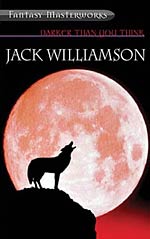
![]() charlesdee
charlesdee
2/5/2012
![]()
Newspapermen and one gorgeous, redheaded, green-eyed newspaperwoman wait on the chilly tarmac of the Clarendon airport for the chartered plane returning the Lamarck Mondrick expedition from their two your stint in Nala-Shan. (Nala-shan actually exists. It's a mountain range in Northern China between Ninxgia and inner Mongolia's Alxa League. This could be the only trace of verifiable fact Williamson brings to his novel.) Along with the press are family members of the four returning explorers, including the elderly, stately Rowena Mondrick, blind since a panther ripped out her eyes in Nigeria some years before
Mark Barbee is there, an old friend of the explorers and now an alcoholic reporter for the Star. He introduces himself to the beautiful readhead, April Bell, novice reporter for Clarendon's rival newspaper. She carries a small snakeskin bag that holds an adorable black kitten. Don't get too attached to the kitten
The plane lands, the much aged and visibly frightened explorers descend the ramp. They carry a heavily locked green case. The enfeebled Mondrick begins a speech, promises world-shattering revelations, then dies of asthma or a heart attack or a combination of the two, Much consternation. April Bell vanishes, but Matt Barbee has already made a date for later that night. His nose for news leads him to a dumpster near the airport terminal where he finds the snakeskin bag containing the kitten. It's been strangled by a red ribbon and it's heart punctured by an ivory pin decorated with a running wolf. It must be that same nose for news that does not make Barbee consider canceling his date
This is the set-up for Darker Than You Think. (Oh, in case you need more clues to coming events, Rowena Mondrick drapes herself in silver jewelry and her mastiff, wearing a silver-studded collar, goes beserk when he sees April Bell.)
Williamson's novel first appeared in John W. Cambell's Astounding in 1940 as a 40,000 word serial. After WWII, the market for science fiction changed. Pulps were losing out to radio and paperbacks, but the now grown-up kids who loved sf from its pulpy origins wanted to see the stories in book form. Lloyd Arthur Eschbach founded Fantasy Press in 1946 and brought out Williamson's The Legion of Space. Respectable sales prompted Llyod to ask Williams to double the length of Darker Than You Think, and its sales equaled those of the previous novel. It's been reprinted many times. The edition I read was a Dell 1979 paperback that reproduced the original drawings by Edd Cartier, whose work, according the book's blurb, adds an extra dimension of enjoyment. Well, maybe. Certainly it adds an extra dimension of camp. My favorite is the frontispiece that features a nude woman seated on the back of a sabre-tooth tiger. She has the perky but nipple-free breasts not uncommon to illustrations of the time
April Bell is a witch, part of the Old Breed that Mondrick wants to eliminate from the earth. Barbee, it turns out, is a shapeshifter himself. I thought is was cheating to have them turn invisible when they took animal form, but it is necessary to make the plot work. Because Williamson wanted to write science fiction and not occult fantasy, he provides some anthropological background for this demon breed and some fanciful physics for why they can walk through walls. This theory is put forth at length several times in dialogue that bears no hint of realistic human speech.
Williamson lists this among his favorite books because it embodied much of what he learned about himself in psychoanalysis. He had been selling erractically to the pulps for years, but in 1936 he hit a wall. (He was 28.) He had been reading about psychiatry and wrote Ives Hendricks , the author of Facts and Theories of Psychoanalysis about coming to Boston from New Mexico for treatment. Hendricks suggested the Menninger Clinic in Topeka and Karl Menniger agreed to see him on April 13. With enough money to live frugally in Topeka, even paying the five dollars an hour for treatment, Williamson stayed. He was under the treatment of Dr. Charles W. Tidd, until two years later when money ran out and he and his doctor agreed there was nowhere further to go at the time
In Darker Than You Think Topeka becomes Clarendon. Glennhaven is an enormous and very active psychiatric hospital where Barbee makes a brief stay. There is too much plot to keep him there for any length of time. What Williamson learned with Dr. Tidd at the Menninger was to let go of some of his inner conflicts and accept parts of himself he had attempted to keep rigidly separated. How this works out for Barbee in the novel some readers found shocking
Darker Than You Think is enjoyable but dated and creaky. Here is a clue to how you might enjoy it more. Imagine it as a black and white movie from RKO studios in the 1940's, produced by Val Lewton and directed by Jacques Tourneur. That is if you want to emphasize the moodier aspects. For a crisper image turn the project over to Robert Wise.
(All the biographical information in this review comes from Williamson's memoirs, Wonder's Child.)
http://www.potatoweather.blogspot.com